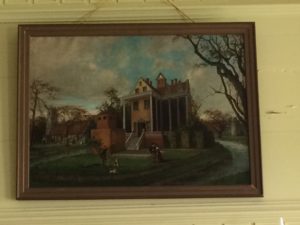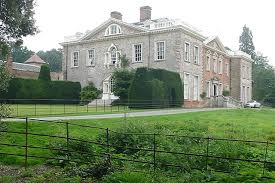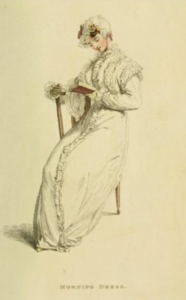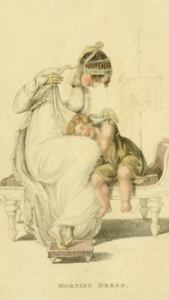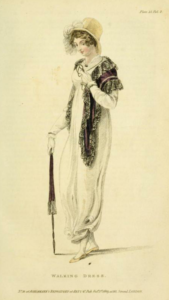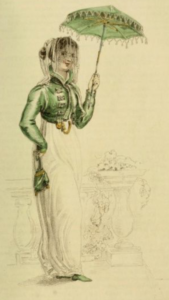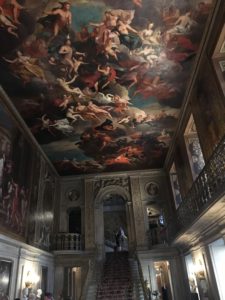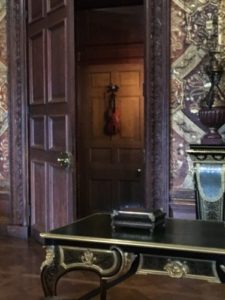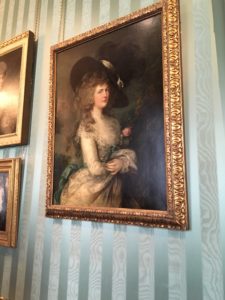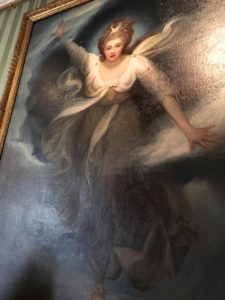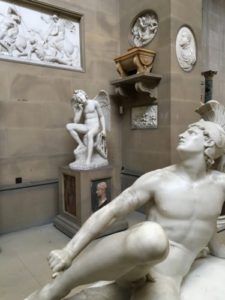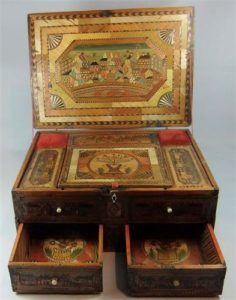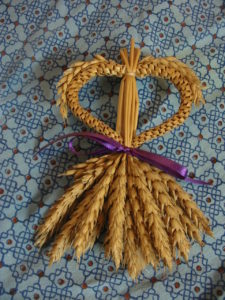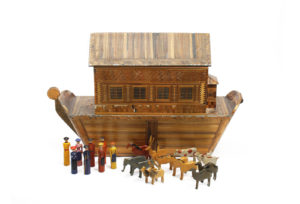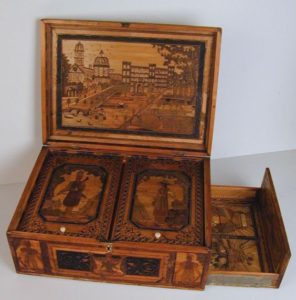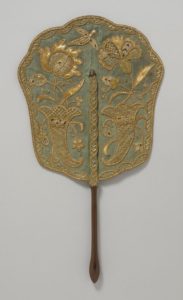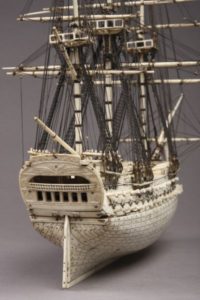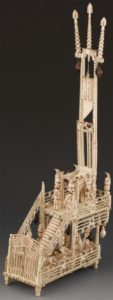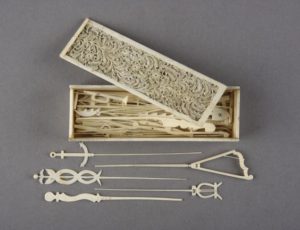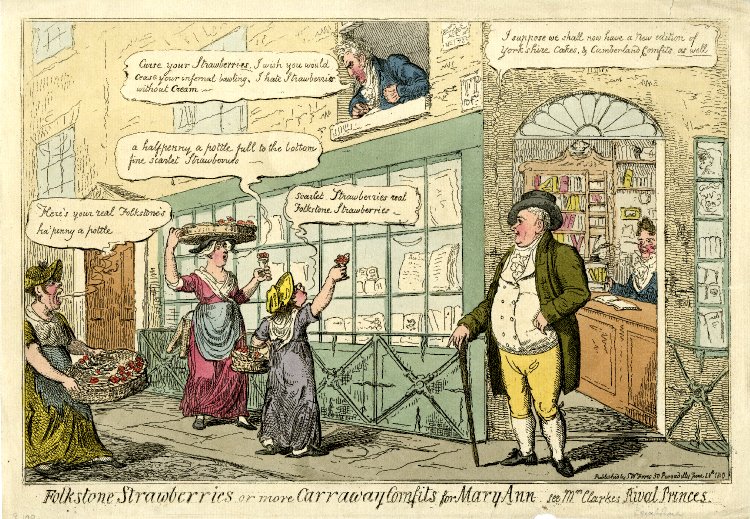
“Folkstone Strawberries or more carraway comfits for Mary Ann,” showing Samuel William Fores’s at the corner of Sackville Street and Piccadilly, c.1810, attrib. Isaac and George Cruikshank. Via Wikimedia Commons.
The above caricature shows a printseller/publisher’s shop window with what mostly appears to be books on display. Windows with lots of small panes were popular in Regency storefronts for at least two reasons (maybe more—I’m not sure how good the technology was for making large sheets of glass at the time):
1. Glass was still taxed by weight. A larger pane requires a thicker weight of glass. (This applied to greenhouses as well, by the way. You see them with lots of little panes.)
2. Shoplifting and property crime was endemic, and a small pane of glass was easier and cheaper to replace if someone broke it to steal your goods. (This was called “starring the glaze” by those in the biz, and here is how it was done, from a 1839 Commissioners Report:
One or two parties divert attention while another “stars.” This is either done by a diamond, or by inserting a small pen-knife through the putty near the corner of a pane and cracking it; the wet finger carries the crack in any direction; an angle is generally formed. The piece is wrought to and fro, and removed; if necessary, another piece is starred, to allow of the free ingress of the hand.
Read the full report to learn more about different theft techniques.)
Small panes also presumably meant it would take a lot more effort and time for thieves to access everything in the store window—and provided a convenient way to display more small wares, because as you can see in the above engraving, they built the windows with lots of tiny shelves to display items in every pane!
Here’s a still of a sweet shop in Bath from the 1995 Persuasion, from this excellent blog post at Jane Austen’s World. I looked at their screencaps a lot while creating the Honey Moon confectionary in my Lively St. Lemeston series.
More Georgian and Regency shop windows:
A printseller. Crowds looking at the prints in printsellers’ windows seem to be a popular caricuture topic because I found LOTS of them. I especially love these dandies picking pockets from this wonderful post on dandy caricatures.
This tavern in colonial America has ivy leaves in the window for Christmas!

“Night,” from the Hogarth series “Four Times of the Day,” 1736. Via Wikimedia Commons.
The dentist/barbershop to the right of this Hogarth painting has a candle in every window pane, probably because at night the windows would reflect and amplify the light back into the room, serving as sconces.
Rundell & Bridge’s in 1822. (For those of you, like me, who are curious about the subject of the caricature: it looks like Lady Conyngham was a mistress of the Prince Regent and involved in political maneuvering about the Privy Purse, i.e. the Regent’s publicly funded allowance from Parliament.)
And here is one of my very favorite things in the Metropolitan Museum, an actual 1775-7 fancy Parisian storefront, carved from oak and stunningly beautiful.
Do you have a favorite shop whose window you like to look in when you go by? There’s a wedding dress store in downtown Seattle that I’m very fond of…

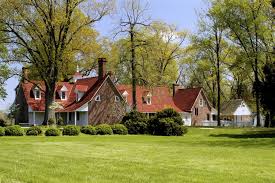 I went on a field trip yesterday with a bunch of museum/history geeks to
I went on a field trip yesterday with a bunch of museum/history geeks to 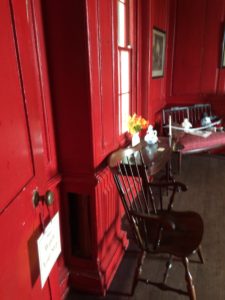 years after, which forms the core of the house. It’s possible to date it so accurately because dendochronology has determined that the cypress posts used in construction date to 1703. This extremely red room, apparently a highly popular color in the period, is the oldest part of the house. There’s a dark rectangle to the right of the notice on the door which is actually a hole cut in the woodwork to reveal the original cypress post.
years after, which forms the core of the house. It’s possible to date it so accurately because dendochronology has determined that the cypress posts used in construction date to 1703. This extremely red room, apparently a highly popular color in the period, is the oldest part of the house. There’s a dark rectangle to the right of the notice on the door which is actually a hole cut in the woodwork to reveal the original cypress post.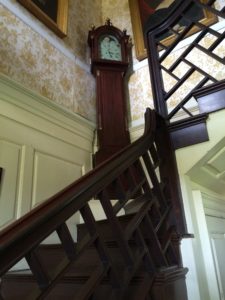 Naturally subsequent owners began to make expansions and improvements, and suddenly, later in the century, Chinoiserie became all the rage. Hence this extraordinary staircase in the expansion of the house undertaken by George Plater III (lots of Georges in this family). He also became a governor of the State of Maryland, and, eew, I cannot get this out of my head: he married a 13 year old who had their first baby when she was 14, and who became, according to the Sotterly website, “a political and social asset to her husband.” Gawd.
Naturally subsequent owners began to make expansions and improvements, and suddenly, later in the century, Chinoiserie became all the rage. Hence this extraordinary staircase in the expansion of the house undertaken by George Plater III (lots of Georges in this family). He also became a governor of the State of Maryland, and, eew, I cannot get this out of my head: he married a 13 year old who had their first baby when she was 14, and who became, according to the Sotterly website, “a political and social asset to her husband.” Gawd.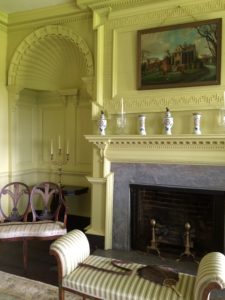 A pretty yellow parlor was added in this period and the shell alcoves in the room are original (built with help from Mt. Vernon’s slaves).
A pretty yellow parlor was added in this period and the shell alcoves in the room are original (built with help from Mt. Vernon’s slaves).